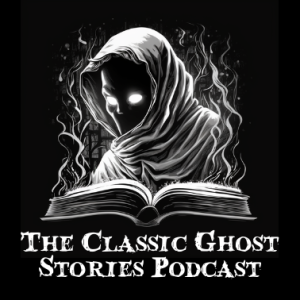
The Horla by Guy de MaupassantWelcome to Episode 35 of the Classic Ghost Stories Podcast!What would really help me would be if you could think of one friend or acquaintance who would enjoy the Classic Ghost Stories Podcast and share it with them! If every listener is helpful enough to do this for me, then we would double the podcast every week!Imagine that!The StoryToday’s story is a famous French short-story by a prolific and highly regarded author: Guy de Maupassant. In fact, he was known as the father of the short story!Guy de MaupassantDe Maupassant was a famous French short-story writer born in France in 1850, who died aged only 42 in 1893 in Paris. He is buried in Montparnasse cemetery.De Maupassant was considered a master of the short story form and his first story, set in the Franco-Prussian War Boule de Suif (A Ball of Suiet) was published in 1880 and is a great story. You may not know that the use of ‘de’ in front of the name (like von in German) indicates noble birth and De Maupassant’s mother urged his father to secure the right, from an ancestor, to so style himself.De Maupassant’s father was violent to his mother and the young lad was witness to this. His mother had the courage and support to separate from his father because of the violence and De Maupassant and his brother went with her. As this was the 1850s or so, this was very rare and very brave of his mother.At school, De Maupassant became friends with Gustave Flaubert. And he saved the life of the English poet Algenon Swinborne from drowning.As a profession, he was a newspaper editor and wrote fiction in his spare time. The HorlaThe Horla was first published in 1887, and is set in 1867 near Rouen in Normandy, France. The narrator is obviously a gentleman — a man of leisure who comes to believe that he is haunted by a monster, which later reveals its name as ‘The Horla.’ This is a nonsense word pronounced in French without the H- (so why then include it, monsieur de Maupassant?) but which I have chosen to pronounce in English with an h.De Maupassant was said to suffer from a mental illness and I recognise the symptoms of anxiety he describes at the beginning but which has become so advanced so that it develops psychotic features — in this case the delusion of the invisible being. There are clear paranoid elements, in that he believes the Horla is a superior being come to replace mankind. There is an example of the secondary rationality that you see in psychosis, where after the clearly irrational primary psychotic insight, in this case that he is possessed by the Horla, then rationality kicks in to explain how this could be so. In his case, he links it to a weird psychic vampire epidemic in Brazil and deduces he was infected when he saluted the Brazilian ship that went by on the Thames, before which he was fine. The power of the the Horla is the same domination of will shown by Dr Parent who hyptonises his cousin Madam de Sable.It all makes perfect sense, but of course is delusional.He shows relatively little remorse for burning his servants alive, I must say, though it wouldn’t be out of the way in many cases of paranoid psychosis that he believed them in on it. Though in this story they clearly aren’t.So, the Horla probably draws on De Maupassant’s real experiences of being mentally ill, but fictionalised. It is possibly this reality that makes the story quite unnerving. I remember being very disturbed by it when I read it first in my teens.MesmerismMesmerism or Animal Magnetism was brought to public attention in the 18th Century by the German doctor Franz Mesmer. It was a fairly weird theory of magnetic fluid, but I’mSupport the show
view more
Visit us here: www.ghostpod.org
Buy me a coffee if you're glad I do this: https://ko-fi.com/tonywalker
If you really want to help me, become a Patreon: https://www.patreon.com/barcud
Music by The Heartwood Institute: https://bit.ly/somecomeback
Learn more about your ad choices. Visit megaphone.fm/adchoices
More Episodes
Wake Not The Dead by Ernst Raupach
 2024-02-09
2024-02-09
 2024-02-09
2024-02-09
The Beast In The Cave by H. P. Lovecraft
 2024-02-02
2024-02-02
 2024-02-02
2024-02-02
Three Miles Up by Elizabeth Jane Howard
 2024-01-26
2024-01-26
 2024-01-26
2024-01-26
The Second Passenger by Basil Copper
 2024-01-19
2024-01-19
 2024-01-19
2024-01-19
The Premonition by Lewis Darley
 2024-01-12
2024-01-12
 2024-01-12
2024-01-12
The Red Lodge by H R Wakefield
 2024-01-05
2024-01-05
 2024-01-05
2024-01-05
The Irtonwood Ghost by Elinor Glyn
 2023-12-29
2023-12-29
 2023-12-29
2023-12-29
Bone to His Bone by E. G. Swain
 2023-12-15
2023-12-15
 2023-12-15
2023-12-15
Couching At The Door by D K Broster
 2023-12-08
2023-12-08
 2023-12-08
2023-12-08
The Gardener by E F Benson
 2023-12-01
2023-12-01
 2023-12-01
2023-12-01
The Horror Under Penmire by Adrian Cole
 2023-11-24
2023-11-24
 2023-11-24
2023-11-24
The Haunted Haven by A. Erskine Ellis
 2023-11-17
2023-11-17
 2023-11-17
2023-11-17
The Canterville Ghost by Oscar Wilde
 2023-11-10
2023-11-10
 2023-11-10
2023-11-10
The Horror at Chilton Castle
 2023-11-03
2023-11-03
 2023-11-03
2023-11-03
Back From The Grave by Robert Silverberg
 2023-10-31
2023-10-31
 2023-10-31
2023-10-31
The Graveyard Rats by Henry Kuttner
 2023-10-26
2023-10-26
 2023-10-26
2023-10-26
The Beast of Averoigne by Clark Ashton Smith
 2023-10-19
2023-10-19
 2023-10-19
2023-10-19
Good Lady Ducayne by M E Braddon
 2023-10-12
2023-10-12
 2023-10-12
2023-10-12
012345678910111213141516171819
Create your
podcast in
minutes
- Full-featured podcast site
- Unlimited storage and bandwidth
- Comprehensive podcast stats
- Distribute to Apple Podcasts, Spotify, and more
- Make money with your podcast
It is Free
- Privacy Policy
- Cookie Policy
- Terms of Use
- Consent Preferences
- Copyright © 2015-2024 Podbean.com






